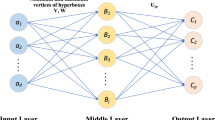Abstract
This paper proposes “A General Fuzzy Min-max neural network with Compensatory Neurons architecture”(GFMCN) for pattern classification and clustering. The network is capable of handling labeled and unlabeled data simultaneously, on-line. The concept of compensatory neurons is inspired from reflex system of the human brain. Fuzzy min-max neural network based architectures use fuzzy hyperbox sets to represent the data cluster or classes. An important stage in the training phase of these techniques is to manage the hyperbox overlaps and containments. In case of GFMCN, compensatory neurons are trained to handle the hyperbox overlap and containment. Inclusion of these neurons with a new learning approach has improved the performance significantly for labeled as well as unlabeled data. Moreover accuracy is almost independent of the maximum hyperbox size. The advantage of GFMCN is that it can learn data in a single pass (on-line). The performance of GFMCN is compared with “General Fuzzy Min-max neural network” proposed by Gabrys and Bargiela on several datasets.
Preview
Unable to display preview. Download preview PDF.
Similar content being viewed by others
References
Zadeh, L.A.: Fuzzy Sets. Information and control 8, 338–353 (1965)
Simpson, P.K.: Fuzzy Min-Max Neural Network–Part I: classification. IEEE Tran. Neural Networks 3(5), 776–786 (1992)
Simpson, P.K.: Fuzzy Min-Max Neural Network–Part II: Clustering. IEEE Tran. Fuzzy System 1(1), 32–45 (1993)
Baitsell, G.A.: Human Biology, 2nd edn. Mc-Graw Hill Book co. inc, NY (1950)
Gabrys, B., Bargiela, A.: General Fuzzy Min-Max Neural Network for clustering and Classification. IEEE Tran. Neural Network 11, 769–783 (2000)
Xi, C., Dongming, J., Zhijian, L.: Recursive Training for Multi-resolution Fuzzy Min- Max Neural Network Classifier. In: 6th Int. Cnf. Solid-State and Integrated Circuit Technology proceedings, Shanghai, October 2001, pp. 131–134 (2001)
Rizzi, A., Panella, M., FrattaleMascioli, F.M.: Adaptive Resolution Min-Max Classifiers. IEEE Trans. on Neural Networks 13, 402–414 (2002)
Abe, S., Lan, M.S.: A Method for Fuzzy Rules Extraction Directly from Numerical Data and Its Application to Pattern classification. IEEE Trans. on Fuzzy Systems 3(1), 18–28 (1995)
Carpenter, G., Grossberg, S.: A Massively Parallel Architecture for a Self-organizing Neural Pattern Recognition Machine. Computer Vision, Graphics & Image Understanding 37, 54–115 (1987)
Carpenter, G., Grossberg, S., Rosen, D.B.: Fuzzy ART: An Adaptive Resonance Algorithm for Rapid, Stable Classification of Analog Patterns. In: Int. joint Cnf. Neural Networks, IJCNN 1991, Seattle, vol. 2, pp. 411–416 (1991)
Nandedkar, A.V., Biswas, P.K.: A Fuzzy Min-Max Neural Network Classifier with Compensatory Neuron Architecture. In: 17th Int. Cnf. on Pattern Recognition (ICPR2004), Cambridge UK, August 2004, vol. 4, pp. 553–556 (2004)
Author information
Authors and Affiliations
Editor information
Editors and Affiliations
Rights and permissions
Copyright information
© 2005 Springer-Verlag Berlin Heidelberg
About this paper
Cite this paper
Nandedkar, A.V., Biswas, P.K. (2005). A General Fuzzy Min Max Neural Network with Compensatory Neuron Architecture. In: Khosla, R., Howlett, R.J., Jain, L.C. (eds) Knowledge-Based Intelligent Information and Engineering Systems. KES 2005. Lecture Notes in Computer Science(), vol 3683. Springer, Berlin, Heidelberg. https://doi.org/10.1007/11553939_161
Download citation
DOI: https://doi.org/10.1007/11553939_161
Publisher Name: Springer, Berlin, Heidelberg
Print ISBN: 978-3-540-28896-1
Online ISBN: 978-3-540-31990-0
eBook Packages: Computer ScienceComputer Science (R0)




